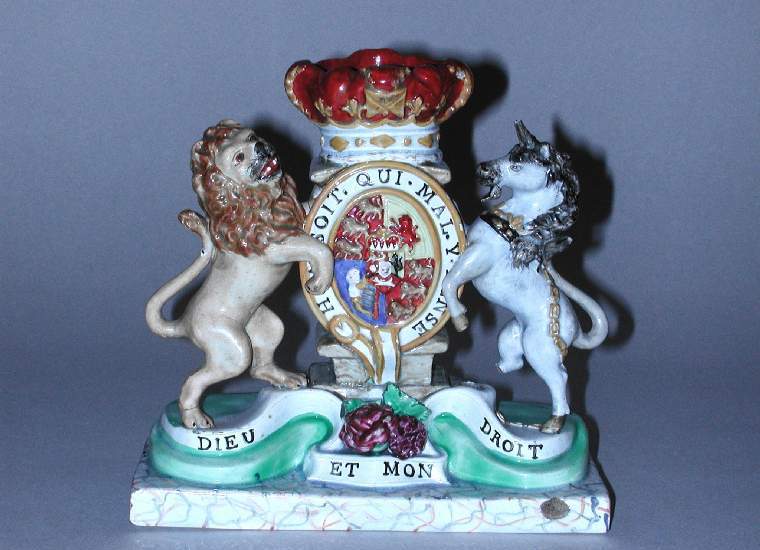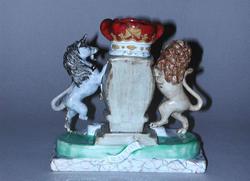Current Location: Gallery 27 (Glaisher)
Titles
The Royal Arms
Maker(s)
Production:
John Walton
Walton, John
Entities
Categories
Description
Lead glazed earthenware spill vase in the shape of the Royal Arms supported by a lion and unicorn, painted in polychrome enamels
White earthenware, moulded, covered with blue tinted lead-glaze, and painted in polychome enamels. In the centre is a spill vase formed from a grey-green column surmounted by a red and gold royal crown. On the front of the column is an oval shield bearing the Royal arms surrounded by the Garter ribbon inscribed ‘HOMI [sic] . SOIT . QUI . MAL . Y. PENSE’, above a rose and thistle. It is supported by the lion and the unicorn, each on its hind legs and standing on a scrolling ribbon inscribed with the motto, ‘DIEU ET MON DROIT’. The inscriptions are incised and coloured black. The group is brightly coloured with enamels over a blue-tinged glaze and stands on a green kidney-shaped cushion supported on a shallow rectangular base coloured to imitate marble. The underside is recessed and glazed. On the back, ‘WALTON’ is impressed on a scroll in relief.
Notes
History note: Captain Reynolds Collection, London, sold to Messrs Gill and Reigate. Bought by Mr George Stoner, London, from whom purchased in 1910 by Dr J.W.L. Glaisher, FRS, Trinity College, Cambridge. Dr Glaisher paid £125 for this and fourteen other pieces, as part of a purchase of 35 figures and figure groups.
Legal notes
Dr J.W.L.Glaisher Bequest, 1928
Measurements and weight
Height: 15.2 cm
Acquisition and important dates
Method of acquisition: Bequeathed
(1928-12-07)
by
Glaisher, J. W. L., Dr
Dating
19th Century, Early
1820
-
1830
Note
‘The Royal Arms’ was probably made to celebrate the accession of either George IV (1820) or William IV (1830). John Walton (1780-c.1835) is listed in an 1818 commercial directory as a colour maker and earthenware figure manufacturer; the business was taken over by his son-in-law George Hood, during the 1830s. His figures are notable for their rich colours, they are often set against bocage (stylised leafy trees) and many of his subjects are taken from porcelain originals; the rectangular ‘marble’ base used here is also typical of his work.
Earthenware figure groups were popular from around 1810, although the earliest examples date from nearly a century earlier. A cheaper alternative to porcelain figures, they were often produced by small potteries; very few are marked. These early figure groups are often complex, including modelled and moulded parts and applied decoration and the backs, though flat, are decorated. But as demand increased, processes were streamlined to allow mass production and by c.1835 the earlier, relatively costly, methods had largely given way to three-part press-moulding.
People, subjects and objects depicted
Components of the work
Decoration
composed of
enamels
lead-glaze
Parts
Materials used in production
White earthenware
Techniques used in production
Moulded
: Earthenware, moulded and modelled, lead glazed and painted with polychrome enamels.
Inscription or legends present
Inscription present: impressed within a relief scroll
- Text: WALTON
- Location: Lower back
- Method of creation: Impressed
- Type: Mark
References and bibliographic entries
-
Catalogue of the Glaisher Collection of Pottery and Porcelain in the Fitzwilliam Museum Cambridge
page(s): 124
-
English Earthenware Figures 1740-1840
page(s): 220-225
-
Staffordshire Chimney Ornaments
page(s): 71-76
-
Staffordshire Potters 1781-1900. A Comprehensive List Assembled from all known Contemporary Directories with Selected Marks
page(s): 239
-
Staffordshire Figures 1780-1840, Volume 2: Equestrians, Entertainers, Personalities, Biblical Figures & Sportsmen,
page(s): 85
-
People, Passions, Pastimes, and Pleasures, Staffordshire Figures 1810-1835
page(s): 163
-
Fine British Pottery and Porcelain, 18 May 2011
Identification numbers
Accession number: C.949-1928
Primary reference Number: 76430
Old object number: 3214
Stable URI
Audit data
Created: Saturday 6 August 2011
Updated: Tuesday 30 April 2024
Last processed: Tuesday 15 July 2025
Associated departments & institutions
Owner or interested party:
The Fitzwilliam Museum
Associated department:
Applied Arts





